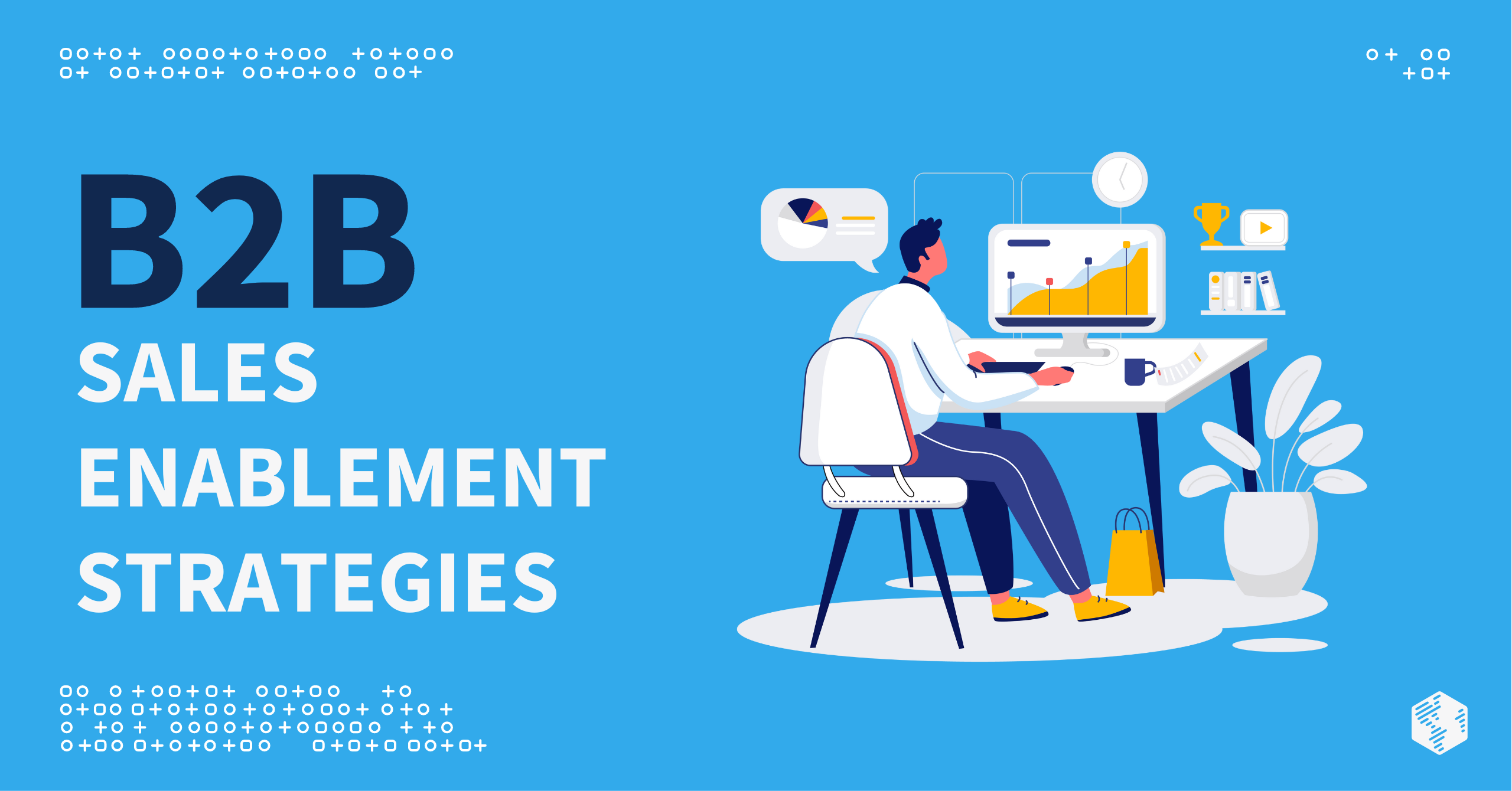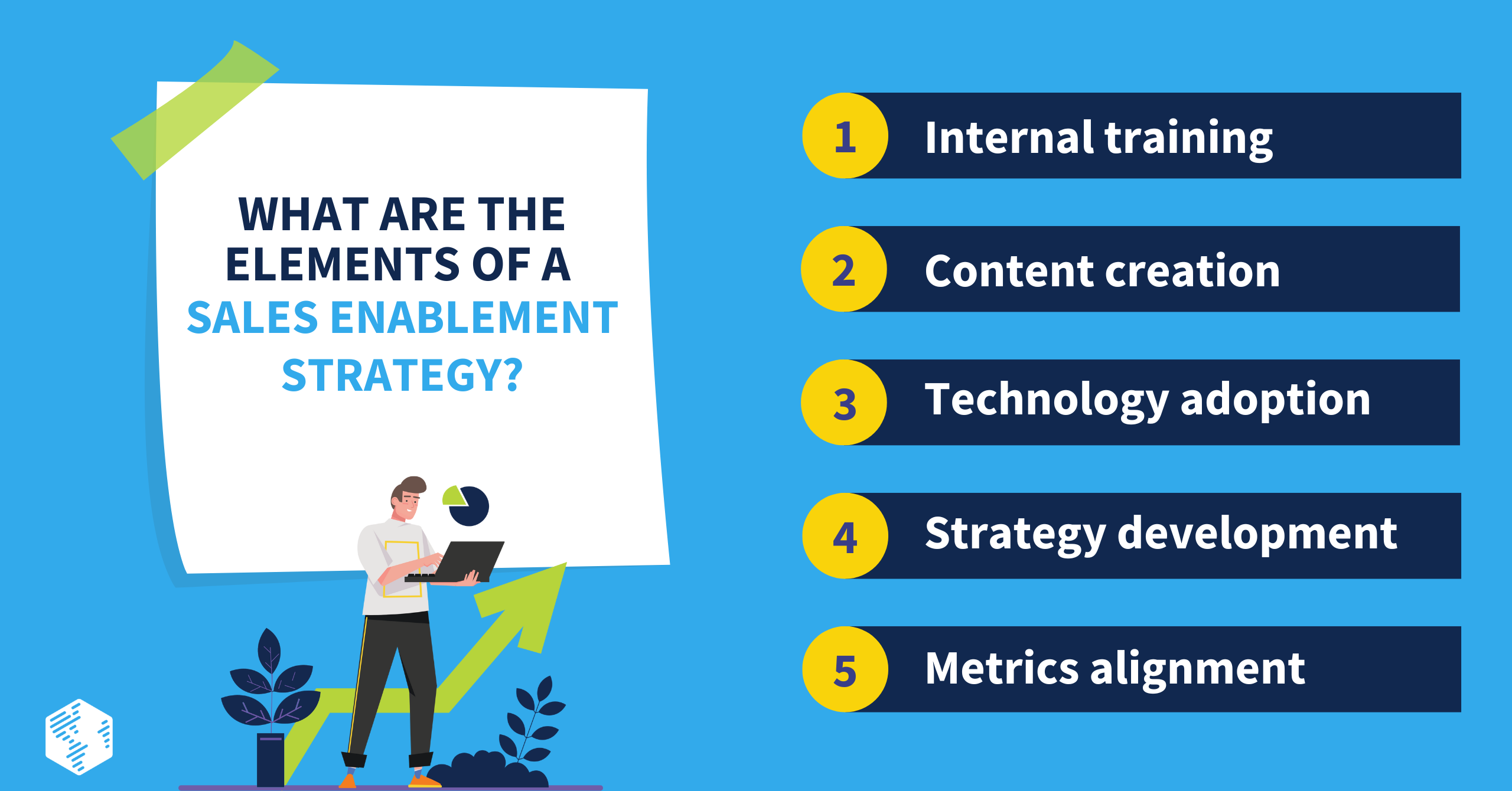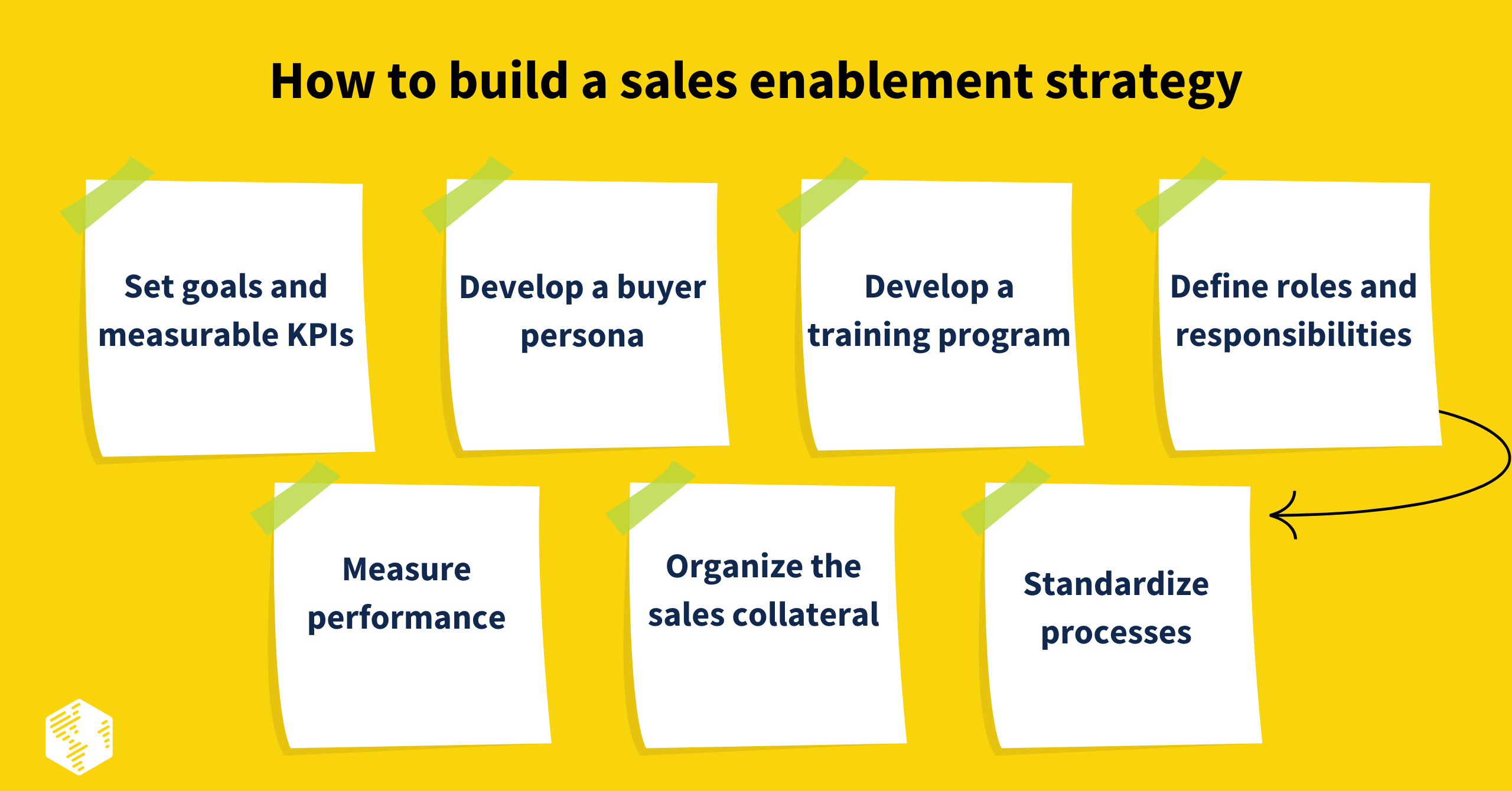How often do your sales teams have to scramble to find the right materials to present to prospects and customers during in-person meetings? How often do you find yourself digging through the countless files and documents trying to adequately address your client’s concerns and pain points – only to end up winging the answers?
In all likelihood, more often than you’d like to admit.
To overcome these struggles and start closing deals without a hitch, you need a sales enablement strategy that streamlines the buyer journey and equips you with the resources you need when you need them.
With all the necessary knowledge, resources, materials, and tools, your sales teams will improve processes and positively impact the bottom line. On average, organizations that use sales enablement see a 49% win rate on their forecasted deals and can experience an increase in sales of between 6% and 20% – not a small feat.
The key is building a strategy that works for you.
Read on to learn how to build a sales enablement strategy that transforms your sales department from the bottom up.
What are the elements of a sales enablement strategy?
Every company is different. How you market your products and services, how you handle customers and guide them through the sales funnel – these are all unique to your organization. Even the same exact enablement strategy will differ from one business to another.
Still, all the key elements of a good strategy will always remain the same.
Internal training
Effective sales enablement starts with comprehensive training – not just during onboarding. Marketing teams, managers, sales reps, and others need to be involved in continual sales training and development. Use these to introduce them to new and existing products and services, keep them updated on the latest organization-wide developments, and familiarize them with new tools and technologies.
Continual training helps ensure that all relevant team members are on the same page, using approaches that match your brand’s voice and persona. It also helps increase employee engagement and satisfaction levels, which ultimately improves performance.
Content creation
To impress clients, attract leads, and close deals, your teams need access to quality content. It allows them to offer value during interactions – from the first time they greet a new prospect to the moment they make a sale.
The type of content needed will differ from one organization to another. However, as a general rule of thumb, you’ll need sales playbooks, case studies, whitepapers, product sheets, blog posts, tutorial and explainer videos, sales presentations, and more.
Technology adoption
An array of tools and technological solutions can help enhance sales enablement, giving the sales teams and clients access to indispensable resources. Some of the most commonly used sales enablement tools include prospecting tools, content management platforms, customer relationship management (CRM) solutions, employee training software, and more.
However, to minimize confusion and streamline sales processes, it’s necessary to be highly selective when choosing the tools. They need to have the right features and integrations with your existing technologies.
Strategy development
All the training, content development, and technological solutions you adopt won’t do much unless you have a strategy on how to use them. For a functional strategy, you must understand the company’s goals, brand voice and persona, the buyer persona, and how your marketing and sales teams operate.
Metrics alignment
The final key component of sales enablement plans is metrics alignment. Your management, marketing, and sales teams need aligned metrics that keep them on the same page and enable you to keep an eye on your sales performance.
That might be the most crucial element of your strategy, as misalignment between teams costs US companies over $1 trillion annually.
The main metrics you’ll want to focus on are content performance, training progress, win rates, average deal size, sales cycle length, the number of required touchpoints before closing the deal, and marketing collateral performance.
READ: B2B Sales: Best Strategies To Grow Your Sales Pipeline With Examples
How to build a sales enablement strategy
You can create a sales enablement strategy in many different ways, but the following will prove to be the most useful. Take a look at these sales enablement best practices that will provide the most value.
Set goals and measurable KPIs
To get started, you’ll first need clear, concise goals. As a general rule of thumb, it’s best to focus on specific process-oriented goals. Instead of simply stating that you need to boost conversions and increase sales, you’ll want to assess how you will achieve this.
What do you need to do to see a change in your sales? What actions must you take to compel customers to agree to a sale? The more precise your answers are, the faster you can achieve your goals.
The second part of the equation is setting measurable key performance indicators (KPIs). Keeping track of KPIs such as lead quality, the number of deals in your pipeline, average lead response times, won and lost deals, and more will help you understand how well your teams are progressing and how good they are at helping you achieve your goals.
Develop a buyer persona
Sales organizations can’t advance with their enablement strategies without developing a detailed buyer persona.
The ultimate purpose of sales enablement is to connect with the buyer and improve their experience. You can only do so if you know their wants and pain points, motivations, interests, and more. You need to connect with the buyer on a personal level, understand where they are on the sales journey, and learn how to best approach them.
Even the best strategy will yield poor results with a poorly constructed buyer persona, so it’s critical to get it right.
Develop a training program
As might be expected, it’s not just sales management or marketing teams that need to be familiar with your enablement goals, KPIs, and buyer personas. Everyone involved in any of the customer contact points will need all-encompassing training that keeps them up to date on the latest developments.
A well-designed training program will help your sales reps develop a unified brand voice and persona that resonates with your customers. You will minimize the risks of your sales reps improvising during their client interactions and keep everyone on the same page.
Define roles and responsibilities
As previously mentioned, sales enablement doesn’t solely concern managers, marketers, and sales reps – it’s invaluable to anyone in customer-facing positions.
Therefore, to ensure that every stakeholder understands what they need to do to improve sales enablement, you must clearly define their roles and responsibilities and provide them with the necessary resources.
Everyone, from your sales rep to the customer support agent, the cashier, and even the receptionist, must know what’s expected of them and how they should approach your clients.
Standardize processes
The easiest way to botch sales enablement is to leave everyone to do as they please. Store files wherever they deem convenient, add new contact details however they see fit, and leave important notes inaccessible to most team members.
To benefit from B2B sales enablement, you’ll need to standardize all processes, from collecting lead information to storing essential files, making reports and analyzing data, and more.
It will help remove any confusion and misunderstandings and provide critical stakeholders easy access to any information whenever they need it.
Organize the sales collateral
Sales collateral might be the most critical element of sales enablement. Therefore, you need to ensure that it’s well-organized and easily accessible.
Whether your sales teams use case studies, whitepapers, product sheets, or anything in between, they need to know where these documents are stored, how they can use different collateral, and when they should rely on it.
Additionally, you’ll need to ensure that all the sales collateral is available online and offline, at premises, and remotely.
Measure performance
Finally, you’ll need to measure and analyze performance consistently. Rely on your pre-defined KPIs to understand how your strategy is progressing and whether there’s any need for improvements. These will also tell you whether all your team members are staying in line with your goals and objectives.
Additionally, you’ll need to be prepared for continual optimization. No sales enablement strategy is perfect – you’ll always need to be tweaking things, making changes, and revisiting your plans.
READ: Top 10 Challenges in B2B Sales And How to Overcome Them
Sales enablement strategies for B2B businesses
The key to making sales enablement strategies for B2B businesses work is aligning sales and marketing departments. It needs to be made clear that sales enablement doesn’t belong to any single department – it’s an organization-wide strategy that requires continual collaboration between sales and marketing.
The marketing department is responsible for providing valuable content and resources that attract the buyer’s interest. The sales department is responsible for using the resources to guide prospects through the sales funnel and ultimately close deals.
Collaboration between the two is necessary to fill in the gaps and build long-lasting relationships with every customer.
Sales enablement strategy example
Imagine this scenario – a new recruit is getting ready for their first client meeting, but they aren’t sure how your products and services work. The recruit also doesn’t know who the client is and why they might want to work with you. They don’t have any resources outside your standard promotional materials that claim you can help them achieve their dreams.
How do you think this scenario would go? Do you believe the new recruit would be effective enough to close the deal?
Highly unlikely.
Now imagine a different scenario – you have just hired a new sales rep. You guided them through comprehensive training, teaching them about your company, its brand voice and persona, its history, and its mission. You have introduced them to your clients and explained exactly how your products and services could benefit them.
You’ve given them access to your marketing materials, case studies, blog posts, and FAQs and provided them with a platform where they can consult their teammates and ask for assistance if needed.
This latter scenario is much more likely to yield better results. Your sales rep will know how to approach the client and make them see your company’s value. They’ll know how to answer questions that haven’t been asked yet and have suitable materials to compel your prospect to sign off on the deal.
That’s what happens with a good sales enablement strategy.
You’re providing even your most inexperienced employees with all the resources they need to increase conversions. You’re not leaving them to fend for themselves but supporting them as they fulfill their responsibilities.
A sales enablement strategy empowers your sales representatives and your entire organization. It unifies your brand persona and allows you to impress your prospects and close deals.
Conclusion
A sales enablement strategy can make all the difference for a B2B organization. It helps you influence the buying process – you can read our previous blog to learn more about it – dispel your prospects’ concerns and worries, and make compelling sales pitches that will increase your conversions.
It helps keep your entire organization unified, organized, and productive. Most importantly, it keeps your marketing and sales teams aligned.
If you need additional assistance in improving the performance of your sales and marketing teams, rely on OneIMS. Feel free to go through our case studies to learn more about our value and explore the solutions we offer.



































